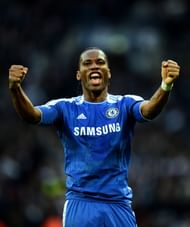The change in football in the past decade has been enormous. The games are faster, players are stronger, managers have come up with more and more complicated tactics and it has come to a point where even a simple throw in has become a powerful weapon, as proven by Stoke City, whose throw ins are much like corner kicks to a certain degree.
As a football fan, to watch this tactical changes have been intriguing. But one of the biggest changes in the modern game is the extinction of the strike partnership.
Looking back, the 4-4-2 formation was the pinnacle of football strategy. Whether the midfield was a flat four or a diamond shape, the frontline remained the same with the two strikers playing off each other. Who can forget the chemistry that was shared by Andy Cole and Dwight Yorke or Thierry Henry and Dennis Bergkamp? So lethal and exiting was their partnership, that it was impossible not to feel impressed by them. Even AC Milan briefly had a wonderful combination upfront with Hernan Crespo and Andriy Shevchenko, who tore Liverpool apart in the first half with their movement in the ultimately ill- fated Champions league final in Istanbul.
In the olden days, the strike partnerships was predominantly 3 types:
-The giant and the dwarf system; where one towering centre-forward provided the physical presence and knock downs and the other striker, a smaller and much quicker player, fed on the knock downs.
-The other system with one out-and-out striker with killer instincts and the other much more subtle and skilful, playing the role of a trequartista or a shadow striker who can dribble, find space and provides assists to his partner.
-The last type, and by far the most exciting system, has two out-and-out forwards with killer instincts and good ball skills, who just want to score goals.
So knowing how impressive and effective this system is, why is it now all but extinct among the top teams?
One can point to Jose Mourinho and Frank Rijkaard as the pioneers of using the one striker system successfully as managers of ‘big’ clubs. The centre forward was flanked by two wingers with a three man midfield in a 4-3-3 formation and later with 3 advanced midfielders playing just behind the main striker and two deep lying midfielders in a 4-2-3-1 formation.
With this formation, the teams are now able to defend more astutely as the wingers drop back and track the runs of the opposition wing backs and with just 1 striker upfront (rather than 2 earlier), the team, as a whole, is able to defend better and press harder with the extra body in midfield. With Jose Mourinho predominantly using a counter attacking system, the two quick wingers help to stretch the defense with their runs, leaving space for the striker and the advancing midfielders to exploit. With the big physical presence of a striker like Drogba who can hold up the ball, the wingers provide an extra dimension rather than passing back to the midfielders.
This system also enables the team to hold possession well by crowding the field with 3 midfielders and the 2 wide players, making it a 5 man midfield and enabling them to play in little triangles and interchange positions, also allowing the wing backs to overlap on the outside while the winger moves inside and all the while having enough bodies between opposition and the goal.
With the success of Didier Drogba and Samuel Eto’o in this system, coupled with the success of their respective teams, the new era had begun. Other clubs started following suit and the trend has continued to this day. Rarely do we see a top side fielding two strikers together anymore. Clubs like Real Madrid, Bayern Munich, Dortmund, Arsenal all use one striker system despite having good options. It has come to the point that when Chelsea signed Demba Ba, the biggest question was who Rafa Benitez going to start – Ba or the much maligned 50 million man, Fernando Torres? It was almost inconceivable that both could start together.
There are still some clubs who don’t necessarily follow the same philosophy. Manchester United still follow 4-4-2 to an extent; but with one striker (currently Robin Van Persie) playing alone at the top with the other (Wayne Rooney) dropping deeper, similar to Liverpool when they had Steven Gerrard playing off Fernando Torres, it essentially becomes a 4-4-1-1 formation.
It is true that modern-day football has become more fluid and intricate with the attacking players interchanging their positions. But with the most recent example of devastating partnership between Edin Dzeko and Grafite, the two forwards for Wolfsburg in their title winning season, it is safe to say that old fashioned strike partnership may still has some value in the modern game.

